Mark Sisson's Blog, page 113
March 10, 2019
Low-Carb & Keto Chayote “Apple” Crisp
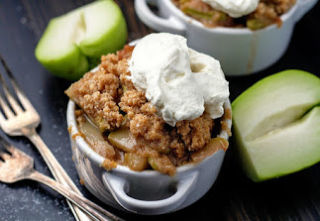 Chayote squash is having its day in the sun as of late, but it’s been used for centuries in Latin American cooking and baking. The chayote squash (also known as mirliton squash) is a mild-tasting, relatively low carb, and versatile fruit with a good dose of vitamin C. Because of its hardness, you’ll definitely want to eat it cooked, but the end result will be worth it: a tender but slightly crisp fruit that bears a resemblance to pear or jicama and that takes on the particular flavors of any recipe—sweet or savory.
Chayote squash is having its day in the sun as of late, but it’s been used for centuries in Latin American cooking and baking. The chayote squash (also known as mirliton squash) is a mild-tasting, relatively low carb, and versatile fruit with a good dose of vitamin C. Because of its hardness, you’ll definitely want to eat it cooked, but the end result will be worth it: a tender but slightly crisp fruit that bears a resemblance to pear or jicama and that takes on the particular flavors of any recipe—sweet or savory.
Note: there’s a little extra prep involved with chayote, but we think the additional few minutes are well worth the approximately 50 grams of carbs spared (full recipe).
Time In the Kitchen: 20 minutes
Servings: 6
Ingredients:
Filling
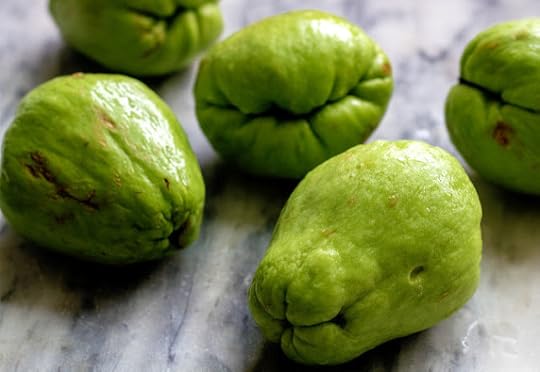
5 cups chayote squash
1 tbsp cream of tartar
5 tsp cinnamon
1 tbsp lemon juice
1/2 cup Swerve (or equivalent of favorite sugar-free sweetener (e.g. monk fruit, etc.)
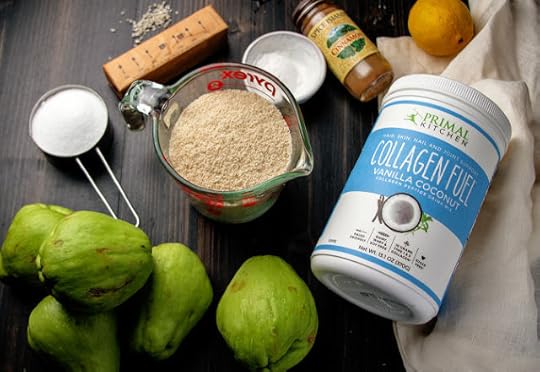
Crumble Topping
2 scoops Vanilla Coconut Collagen Fuel
Good pinch of salt
1 tsp. cinnamon
2 c. almond flour
1/2 cup melted grass-fed butter
Instructions:
Preheat oven 350 ºF/175 ºC
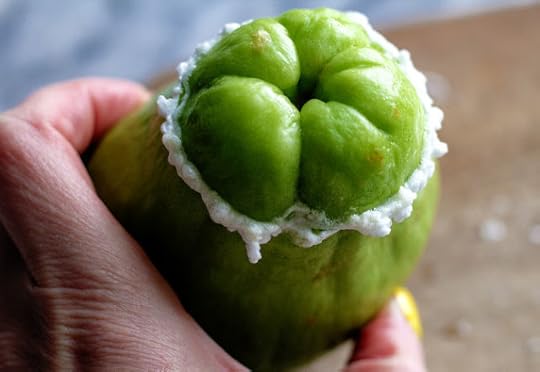
Prep the squash. (This video has a good rundown of the process.) In a nutshell, cut the top inch off the fruit and let the liquid bubble up on the exposed flesh of the fruit. Rub the cut top piece over the exposed area for a full minute to draw up and out more liquid. This will create a froth as pictured. After the full minute, wipe off this froth with a clean paper towel. (Although the liquid/froth is completely safe, it may cause a mild tingly feeling if you get it on your fingers.)
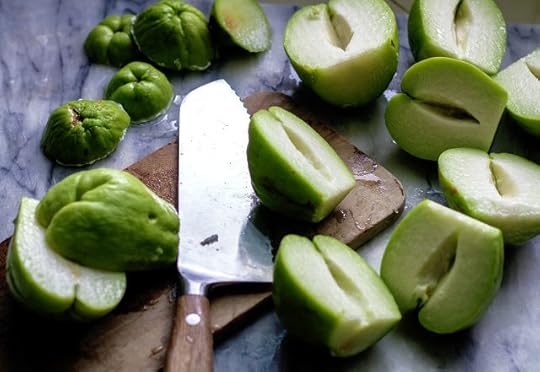
Cut the fruit in half and remove the seed, along with the white flesh directly around it.
Cut squash into 1/4 inch slices.
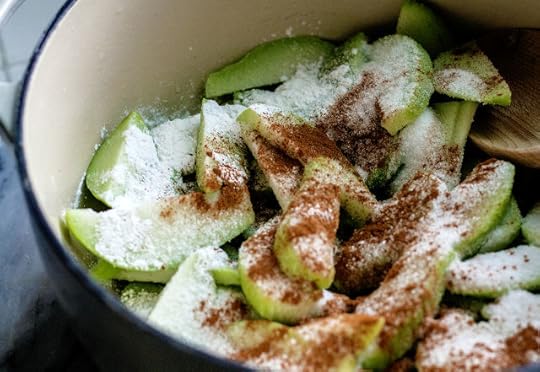
Place in pot along with cinnamon, arrowroot or cream of tartar, lemon juice and sweenter. Cook over medium heat for about 10 minutes so that the squash starts to become tender.
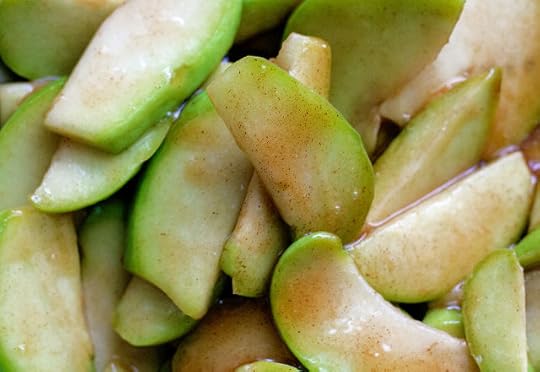
Pour into ramekins.
Put all the crumble topping ingredients into a food processor and pulse until the butter is well incorporated and it looks good and crumbly.
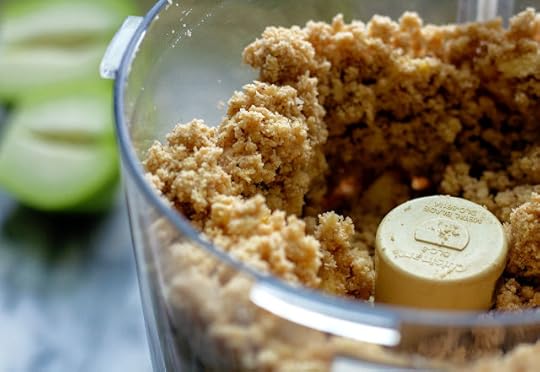
Pour over top of squash.
Bake 30 minutes (or 45 minutes if baking as an 8-inch pie)
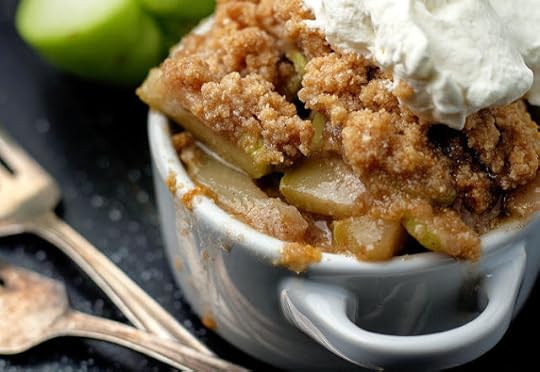
Nutritional Information (per serving)
Calories: 345
Net Carbs: 8 grams
Fat: 28 grams
Protein: 12 grams

The post Low-Carb & Keto Chayote “Apple” Crisp appeared first on Mark's Daily Apple.



March 8, 2019
Weekly Link Love—Edition 19
 Don’t Miss the Deadline! Today (3/8/19) is the last day to enter the success story giveaway! Three prizes in all for three randomly chosen (complete = write-up and photos) submissions: a $200 Primal Kitchen gift certificate for one person and a 5-book Primal library for two additional people. Everyone submitting (at any time) will receive a 20% off voucher for an order of their choosing on PrimalKitchen.com or PrimalBlueprint.com. Email me your story along with pictures. Please use the subject heading “My Primal Story.” Complete details here.
Don’t Miss the Deadline! Today (3/8/19) is the last day to enter the success story giveaway! Three prizes in all for three randomly chosen (complete = write-up and photos) submissions: a $200 Primal Kitchen gift certificate for one person and a 5-book Primal library for two additional people. Everyone submitting (at any time) will receive a 20% off voucher for an order of their choosing on PrimalKitchen.com or PrimalBlueprint.com. Email me your story along with pictures. Please use the subject heading “My Primal Story.” Complete details here.
Research of the Week
Sperm bottlenecks select the strongest.
In the moment, work isn’t so bad.
Compared to controls, teams made up of CEOs are better at cooperating together in strategic games.
Injectable nanoparticles allow mice to see infra-red.
Neurons repair themselves during sleep.
I bet giant ground sloths were delicious.
New Primal Blueprint Podcasts

Episode 317: Jimmy and Christine Moore: Host Elle Russ chats with Jimmy and Christine Moore about their new book Real Food Keto.

Episode 318: Keto Q&A with Brad Kearns: Host Brad Kearns answers your keto questions.

Health Coach Radio Episode 2: Chris Kelly: Hosts Erin Power and Laura Rupsis chat with Chris Kelly, founder of Nourish Balance Thrive, which uses detailed lab testing to construct personalized action plans for clients.
Each week, select Mark’s Daily Apple blog posts are prepared as Primal Blueprint Podcasts. Need to catch up on reading, but don’t have the time? Prefer to listen to articles while on the go? Check out the new blog post podcasts below, and subscribe to the Primal Blueprint Podcast here so you never miss an episode.
Media, Schmedia
Bridge player busted for doping.
Interesting Blog Posts
How muscle memory actually works.
Scientists wonder why human breasts are so persistent.
Social Notes
A great opportunity to win some delicious treats.
Everything Else
After introducing low-carb to his type 2 diabetic patients in a rural West Virginia hospital and having great success, Dr. Mark Cucuzzella wrote clinical guidelines for other hospitals to follow. Huge news if this catches on.
Fairy tales are way older than you think.
What happened to the hat?
Things I’m Up to and Interested In
Podcast I enjoyed: Tim Ferriss talks to Michael Pollan about psychedelics. “Don’t take anything your grandmother wouldn’t have encountered at Woodstock.”
I’d wear a coat made of this to keep warm: Cross-section of Emperor penguin.
Article I’m reading: Fiber and Colon Health on a Well-Formulated Ketogenic Diet
Interesting study: Men donate the most to panhandlers when in the company of a woman.
I didn’t think anyone else did this exercise but me: The Tinkerbell.
Question I’m Asking
How do you play?
Recipe Corner
Keto cacao smoothie, with video.
Paleo hoisin sauce from Nom Nom Paleo.
Time Capsule
One year ago (Mar 3 – Mar 9)
Why the Type of Folate You Take Matters – What are you taking?
6 Older Studies That Got No Love But Should Have – Older studies aren’t worser studies.
Comment of the Week
“We’ve established that nitrates should come from plants, not chemical plants.”
– Even though I’m not completely sure I agree, that is a very good line, Angelica.

The post Weekly Link Love—Edition 19 appeared first on Mark's Daily Apple.



March 7, 2019
My Favorite Way To Play: Ultimate Frisbee Workout (with Video)
 I’m a believer in working hard AND playing hard. When we get stuck in patterns of overwork and overstress, we lose the important connection with our creative, intuitive, playful selves. Our work suffers and so does our happiness (which means everything else, like our relationships, will, too). Stuart Brown, one of the world’s leading experts on play, calls play a “profound biologic process.” What we all know (or used to know until modern living helped us forget) is that play is an essential component of our physical development and general well-being. From a personal standpoint, the older I get the more I recognize play as the linchpin for my own sense of vitality. As a result, I prioritize play—even above exercise. Fortunately, however, I’ve grown into a new relationship with fitness as a result of play. I gave up the slog of grueling training regimens decades ago now, but to this day I’m still living more deeply into a play-based fitness vision. Let me show you a bit of what that looks like for me….
I’m a believer in working hard AND playing hard. When we get stuck in patterns of overwork and overstress, we lose the important connection with our creative, intuitive, playful selves. Our work suffers and so does our happiness (which means everything else, like our relationships, will, too). Stuart Brown, one of the world’s leading experts on play, calls play a “profound biologic process.” What we all know (or used to know until modern living helped us forget) is that play is an essential component of our physical development and general well-being. From a personal standpoint, the older I get the more I recognize play as the linchpin for my own sense of vitality. As a result, I prioritize play—even above exercise. Fortunately, however, I’ve grown into a new relationship with fitness as a result of play. I gave up the slog of grueling training regimens decades ago now, but to this day I’m still living more deeply into a play-based fitness vision. Let me show you a bit of what that looks like for me….
You all have heard me talk about Ultimate—probably as long as Mark’s Daily Apple has been around. The fact is, it’s as thrilling for me today as it was twelve years ago. Nothing else quite combines the diversity of essential movement and the heart of play like Ultimate does. In a single hour, I’m getting regular sprinting, lateral movement, agility training, recovery phases, and mind-body coordination to skillfully throw, catch and move on the field. I love the intense challenge and fast pace of the game.
Ultimate plays very similarly to rugby or football. The field has two end zones, and a team scores by catching a pass in the defensive team’s end zone. The defending team performs a “pull” (think “kickoff” in football) to start the match (and after every subsequent point scored). The offense moves the disc by passing to teammates in any direction. Once a player catches the disc, he must come to a stop as quickly as possible. From this position, he can only move his non-pivot foot. A player has ten seconds to throw the disc after catching it.
The disc changes hands either by turnover or after a score. A turnover occurs when a pass is not completed, intercepted, dropped, blocked, held for longer than the allotted ten seconds, or thrown out of bounds. The defending team assumes control of the disc immediately following a turnover, from wherever the disc lands on the field. There is no stoppage of play (unless a foul, injury or bad weather occurs).
From a physical standpoint, you’re out there running, leaping, twisting, grabbing, throwing, and bumping into other players. You use practically every muscle in the body (if you’re not, you’re doing it wrong) and, rather than long protracted runs, you engage in short bursts of speed and activity punctuated by walking and brief jogging (almost like you’re on the hunt). Not only does it take keen, quick thinking, remarkable agility and throwing accuracy, and raw athleticism, but it also promotes good teamwork and sportsmanship. In fact, Ultimate has an official “Spirit of the Game” (SOTG), a sort of mission statement that stresses sportsmanship and honor. Highly competitive play is condoned, but not at the cost of general camaraderie. Everyone is out there to have a good time and get some great exercise.
Check it out.
Want more ideas for active play? Here you go.
15 Concrete Ways To Play
Crawling, Balancing, Rolling: The Importance of Practicing Natural Movements
10 Ideas To Make Workouts More Fun
The 10 Rules of Successful Exercise
Workout Suggestion: Planned Spontaneity
And for more on the importance of play for a Primal Blueprint lifestyle, check out these resources.
The Definitive Guide To Play
The Lost Art of Play: Reclaiming a Primal Tradition
The Importance of Play, Long Walks and Outdoor Workouts—Or Why the Optional Stuff Isn’t Actually Optional
Now you tell me: what’s your favorite way to play? How do you merge the Primal goals of mobility and fitness with everyday enjoyment? Thanks for stopping in today.
The post My Favorite Way To Play: Ultimate Frisbee Workout (with Video) appeared first on Mark's Daily Apple.



March 6, 2019
4 Misunderstandings About Carbs and Stress
 The relationship between stress and carbohydrates is confusing, with seemingly contradictory arguments bouncing around the online health sphere.
The relationship between stress and carbohydrates is confusing, with seemingly contradictory arguments bouncing around the online health sphere.
There are those who say high-carb diets cause stress, and that eating more fat and fewer carbs is the solution.
There are those who say high-fat diets increase stress and eating carbs ameliorates it.
Who’s right? They can’t both be right, can they?
Well…
You’d be surprised.
Let’s dig into four common carb questions and assertions.
“Stress Increases Carb Cravings.”
This is well-established. You have a terrible day at the office, your kids have appointments twenty miles apart within fifteen minutes of each other, the traffic is backed up to your driveway, you’re late for work, the dog needs a walk, you haven’t even thought about what to make for dinner, you slept four hours last night—it adds up. People deal with a lot. And in that moment, a carbohydrate-based snack really does seem to take the edge off.
Across millions of years of hominid evolution, the human stress response developed in the context of real-world, short-term, and infrequent but intense stressors: battles, hunts, freak injuries, dangerous animal encounters, interpersonal conflicts. These were situations that demanded heightened senses, available fuel, and a rapid heart rate to deliver everything to the tissues that needed to move and act. It makes perfect sense for your body to pump out adrenaline to increase fat burning and glucose in the blood—you need that fuel to deal with the situation. It also makes sense for your body to follow that up with a blast of cortisol, which makes you crave high-carb junk food to replace the fuel you utilized. The problem is that our modern stressors are too frequent, they aren’t physically demanding, we aren’t utilizing the fuel we mobilize, and we have no real need for the carb cravings that come after.
What happens when we eat too many carbs that we never actually needed?
We get fat. Cellular energy supply becomes overloaded, impairing our mitochondria’s ability to process energy efficiently. This degrades metabolic flexibility—the ability to switch between different fuel sources—preventing us from burning the fat on our bodies in between meals. We become reliant on those carbs, and when we don’t get them fast enough, our bodies perceive that as a major stressor.
So while giving in to carb cravings can reduce stress in the short-term, it sets us up for longer-term, more chronic stress.
“What About Gluconeogenesis? Isn’t That a Stress Response?”
It can be.
A primary goal of cortisol is to increase glucose availability. It does this through multiple avenues. One I just mentioned is to increase carb cravings. Another is to make you insulin resistant, thereby preventing insulin from sucking up blood glucose. Gluconeogenesis—the creation of glucose from amino acids and other substrates—is another.
If you’re a sugar-burner, stressful situations will increase carb cravings, induce gluconeogenesis, and may even make you insulin resistant. If you’re fat-adapted, the story shifts.
A fat-adapted person will have ketones and fatty acids available to provide energy in between meals. A fat-adapted person will have ketones and fatty acids available to provide energy in stressful situations. A fat-adapted person will be able to utilize those ketones and fatty acids during stressful situations—their mitochondria will literally be primed to utilize those fuels, not just glucose. A fat-adapted person is less likely to perceive carbohydrate shortages as stress shortages because they’ve got all this other fuel available to burn.
This adaptation doesn’t happen overnight. If your diet is low-carb or keto, but your body is still reliant on sugar, you will perceive reduced carb availability as a stressor. That’s one of the hallmarks of the keto flu, and it’s one reason why some people have extended keto flu—their bodies are still expecting and demanding glucose.
Some people never get over the carb cravings; they never fully adapt. This is the subset of the population that doesn’t function or perform well on a long-term ketogenic diet. The cause is unknown, at least for now (I suspect it has to do with recent ancestry and genetic proclivities), but what matters is that these people exist. For them, a long-term keto or very low carb diet approach will probably always be stressful. But even in these folks, spending some time in ketosis—through short term low-carb eating, intermittent fasting, or even extended low-level endurance activity that primarily burns fat—is a good idea that will reduce stress and improve overall resilience.
“But Carbs Make Exercise Less Stressful!”
Exercise is stressful to begin with. But then you adapt to the stress and overcome it—and end up stronger, fitter, and faster than before. Without the stress, working out doesn’t work. A legitimate method for increasing your work capacity is to train-low (carb), race-high (carb). Athletes have been doing this for decades—training in a low-carb state to get better at performing without ample muscle glycogen, then going into a race with full glycogen reserves and the ability to perform without glycogen. Exercising in that low-glycogen state is stressful, but that’s the whole point. It makes them better, stronger, faster, and it conserves glycogen for when they really need it.
If you consistently perform glucose-intensive high-intensity anaerobic activity for extended periods of time—CrossFit style WODs done 3-5 times per week, for example—you will run up a glucose debt and should replenish some of the carbohydrates you expend or risk cortisol spikes. Fat-adaptation can improve your tolerance of anaerobic activity in a low-glucose state, but there’s a breaking point, a physiological limit.
Eat the carbs you earn. This is a subtle point I don’t often see made. The reverse is widely understood—don’t eat the carbs you don’t earn—because millions of obese and overweight people do that every day. It’s a big reason why we’re so overweight. But if you fail to eat the carbs you earn through intense, protracted physical activity, you’re creating an undeniable glycogen deficiency that your body may perceive as a stressor. It may turn out that fully fat- and keto-adapted athletes can perform intense medium-to-long-term activities at high levels, and there’s some indication that this is the case, but for the time being it appears that eating the carbs you earn can stave off the stress.
“Low-Carb Diets Are Stressful For Women.”
There’s a glimmer of truth here. Allow me to explain.
Women are inherently more sensitive to caloric fluctuations than men…on average. The reason is sheer biology. Human evolution is concerned with fertility and reproduction. Can you produce, foster, and support viable offspring? Awesome. Natural selection deems you fit.
To fulfill their biological role, men have to produce sperm. They can do so almost indefinitely. They don’t run out; they just make more. If a batch is damaged due to poor lifestyle or dietary choices, there’s more on the way. After a man gets someone pregnant, his biological involvement with the growing baby is done. What or when he eats has no impact on the survival of the growing baby.
To fulfill theirs, women have a finite number of eggs, or “chances.” Once an egg is gone, there’s no replacing it.
And so the body seeks to inculcate the egg from environmental insults.
When you are preparing to get pregnant, your body needs extra nutrients to build up a reserve and “prime the pump.”
When you are pregnant, the growing baby needs a reliable and constant stream of nutrients for almost a year.
After you’ve given birth, the growing newborn needs breastmilk. To make that milk requires additional calories and extra doses of specific nutrients. Modern technology allows us to skip nursing and go straight to the bottle, but your body doesn’t “know” that.
It all points to women being more finely attuned to caloric deficits. For example, women’s levels of ghrelin, the hunger hormone, are quicker to rise after meals. Even if you’re never going to have kids, your body is still wired to protect against these caloric fluctuations.
Where do carbs come in?
One’s carbohydrate consumption is uniquely hewed to our sense of caloric sufficiency. If carbs are plentiful, your body perceives that as a signal of environmental plenty: the weather is good, the plants are producing, the trees are bearing fruit, the men are bringing back lots of honey. Life is good. It’s the perfect time to get pregnant. Above all other macronutrients, carbohydrate consumption increases the short-term expression of leptin, a satiety hormone that signals the presence of incoming calories, caloric sufficiency, and environmental plenty.
There’s also the issue of extreme satiety. Low-carb diets often become low-calorie diets without you even trying. That’s why they work so well for fat loss, by inadvertently reducing the amount of food you eat and increasing satiety. But for some women, especially those at or approaching their ideal weight, going too low in calories can increase stress.
Summing Up…
Are you unable to access your own body fat in between meals for energy? Then you’ll be a ball of stress unless you can get those Jolly Ranchers unwrapped quickly enough. It’ll be a constant battle. And yeah, if you keep pumping yourself full of carbs to keep your blood glucose topped off, you’ll keep stress at bay—but you’ll always be teetering on that precipice.
Are you exercising? Then you should strike a balance between gaining the adaptive benefits of training in a low-carbohydrate state and eating the carbs you earn.
Are you a woman? Then you’re probably more sensitive to diet-induced stress and may benefit from occasional carbohydrate refeeds. You should watch out for excessive satiety on ketogenic diets, which is great for fat loss but can lead to stress issues down the line if calories get too low.
The relationship between carbohydrates and stress isn’t exactly straightforward, but it is navigable. Hopefully after today you have a better idea of where you stand in the relationship.
What’s been your experience with stress and carbohydrates? Has your tolerance for stress gone up or down since going low-carb or keto? Thanks for stopping in today.

References:
Mcallister MJ, Webb HE, Tidwell DK, et al. Exogenous Carbohydrate Reduces Cortisol Response from Combined Mental and Physical Stress. Int J Sports Med. 2016;37(14):1159-1165.
Dirlewanger M, Di vetta V, Guenat E, et al. Effects of short-term carbohydrate or fat overfeeding on energy expenditure and plasma leptin concentrations in healthy female subjects. Int J Obes Relat Metab Disord. 2000;24(11):1413-8.
The post 4 Misunderstandings About Carbs and Stress appeared first on Mark's Daily Apple.



March 5, 2019
Ultimate Guide to Non-Dairy Milks
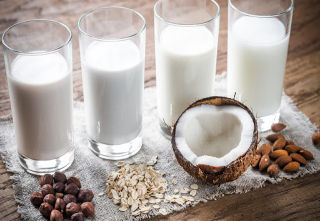 Some people just don’t do milk.
Some people just don’t do milk.
There are many reasons why. Maybe you have a dairy intolerance. Maybe you don’t like the way cow’s milk tastes. Or maybe you think cow milk is unhealthy.
I won’t contest the reasons why. That’s another topic for another post, and I’ve already covered the most common anti-dairy arguments. If you want to read about my stance on the healthfulness (or lack thereof) of dairy, read what I’ve written about raw milk, cheese, yogurt, and dairy in general. If you want to learn how to identify dairy intolerance, read this.
But the fact is, lots of people either need or want a milk alternative. Water is great to drink, but it’s not the right smoothie substrate, and it can’t replace milk in recipes or coffee drinks. You need something vaguely white and thick enough to pass as milk.
Normally in a post like this, I’d cover all the different varieties and what sets each apart—their strengths and weaknesses, their nutrient profiles, their unhealthy ingredients. And I’ll certainly do that today, but first there’s good news and bad news.
The good news is that there are plenty of good choices available. If you want something to drink, use in smoothies, or add to coffee, there are many different plant-based milk that avoid overly offensive ingredients.
The bad news is that most non-dairy milks are usually very low in nutrients. The parent food to these plant-based milks—the almonds, the cashews, the hemp seeds, and so on—are extremely nutrient-dense in and of themselves. Just check out my posts on nuts and seeds to get the nutritional lay of the land. But almond milk isn’t almonds, cashew milk isn’t cashews, and hemp seed milk isn’t hemp seeds.
This isn’t surprising when you think about how nut milks are made: by blending the nuts with a bunch of water and straining out the solids to try to extract some of the nut-ness. It’s pretty inefficient. If you could press an almond to wring out the almond milk, then you’d have something interesting. But that’s not how it works. Most non-dairy milks are superficial mirages of the real thing.
To illustrate this, let’s look at the most popular non-dairy milks and compare the nutrients in the parent nut/seed/plant to the nutrients in the nut/seed/plant-milk (when applicable).
Nutrient Profiles Of Popular Non-Dairy Milks
Almond Milk
This is the go-to option for most strict paleo eaters starting out. It sounds like a great idea. Almonds are a nutritious nut, high in magnesium, copper, vitamin E, and manganese. They have a decent amount of protein, some nice prebiotic fiber. In your head, almond milk is fantastic. Unfortunately—and this goes for most of the other nut milks out there—the average jug of store-bought almond milk contains no more than a handful of almonds.
In an ounce of almonds:
163 calories
6 g carbs: 3.5 g fiber
14 g fat: 8.8 g MUFA, 3.4 g linoleic acid (LA), 1.1 g SFA
6 g protein
50% vitamin E
22% vitamin B2
31% copper
18% magnesium
28% manganese
In a cup of almond milk:
36 calories
1.4 g carbs
2.6 g fat: 1.7 g MUFA, 0.6 g linoleic acid
1.4 g protein
45% vitamin E (added)
17% vitamin A (added)
25% vitamin D2 (added)
4% magnesium
4% manganese
39% calcium (added)
8% copper
Not great carry over. No prebiotic almond fiber. Almost no protein, magnesium, manganese, or copper. The richest nutrients are all the ones they added after the fact.
Cashew Milk
Cashew milk is in the same boat: mostly water, not too much cashew.
In an ounce of cashews:
156.8 calories
8.6 g carbs: 0.9 g fiber
12.4 g fat: 6.7 g MUFA, 2.2 g LA, 2.2 g SFA
5.2 g protein
10% vitamin B1 (thiamine)
69% copper
24% iron
20% magnesium
20% manganese
15% zinc
In a cup of cashew milk:
25 calories
1.4 g carbs: 0.2 g fiber
2 g fat: 1.1 g MUFA, 0.4 g linoleic acid
0.8 g protein
2% vitamin B1
11% copper
4% iron
3% magnesium
3% manganese
2% zinc
17% vitamin A (added)
25% vitamin D2 (added)
18% vitamin E (added)
37% calcium (added)
Coconut Milk
Traditionally, you make coconut milk by pulverizing fresh coconut flesh, blending it with a little water, and passing it through a cheesecloth or fine strainer. This produces a very rich, very high-fat milk that runs about 550 calories per cup. This is the coconut milk used in cooking that comes in cans and cartons. A second pass with the coconut solids produces a thinner, less-rich coconut milk that runs about 150 calories per cup. This is often called “Lite Coconut Milk” and can be used to cook or to drink.
Besides the abundance of medium chain triglycerides and a lot of manganese, neither thick or thin coconut milk are nutrient-dense. A cup of rich, full-fat coconut milk gives decent amounts of magnesium, copper, zinc, selenium, and iron, but you have to realize that it takes 600 calories to get those nutrients. That’s not exactly nutrient-dense; the micronutrient-to-calorie ratio is skewed.
They do sell jugs of thin coconut milk as a milk replacement. Except for the fortifications they add (vitamin D, calcium, riboflavin, and the other usual suspects), these aren’t going to supply much in the way of nutrition.
Flax Milk
In an ounce of flaxseed:
151.4 calories
8.2 g carbs: 7.7 g fiber
12 g fat: 2.1 g MUFA, 6.5 g ALA (omega-3), 1.7 g LA, 1 g SFA
5.2 g protein
39% vitamin B1 (thiamine)
38% copper
20% iron
26% magnesium
31% manganese
13% selenium
11% zinc
In a cup of flax milk:
25 calories
1 g carbs
2.5 g fat: 1.2 g ALA (omega-3)
5% iron
63% B12 (added)
25% vitamin D2 (added)
17% vitamin A (added)
25% calcium (added)
The main standout is the omega-3 content. Flax milk has a little over a gram of alpha-linolenic acid (the plant form of omega-3) per cup.
Hemp Milk
I’m not talking about the oncoming wave of high-THC cannabis milks. This is hemp milk, produced by blending non-psychoactive hemp seeds with water and straining the solids out.
In an ounce:
149.1 calories
7.8 carbs: 7.8 g fiber (all fiber)
10.1 g fat: 1.1 g MUFA, 2.2 g ALA, 4.8 g LA, 0.8 g SFA
7 g protein
24% vitamin A
63% copper
50% iron
33% magnesium
86% manganese
13% selenium
18% zinc
In a cup of hemp milk:
70 calories
2.2 g carbs, all fiber
6 g fat, 1 g ALA (omega-3), 3 g omega-6
2 g protein
18% copper
13% iron
10% magnesium
24% manganese
Plus all the usual fortifications (calcium, vitamin D, vitamin A, riboflavin, vitamin B12
That’s not too bad, actually. It picks up some decent mineral levels, and hemp fat is one of the only fats to contain stearidonic acid, an intermediate omega-3 fat in the conversion pathway from ALA to EPA that increases the EPA content of red blood cells in humans (a very good thing).
Macadamia Milk
There’s a product called Milkadamia. Great name, disappointing result.
In an ounce:
203.5 calories
3.9 g carbs: 2.4 g fiber
21.5 g fat: 16.7 g MUFA, 0.4 g LA, 0.1 g alpha linolenic acid (ALA), 3.4 g SFA
2.2 g protein
28% vitamin B1 (thiamine)
24% copper
13% iron
51% manganese
In a cup of mac nut milk:
50 calories
1 g carbs
5 g fat
1 g protein
125% vitamin B12
17% vitamin D
25% vitamin A
38% calcium
Despite having the best product name and the most potential for being a creamy milk substitute (has anyone tried adding mac nuts to a smoothie?—incredible!), the nutrient profile is low, and there’s not much going on.
Oat Milk
I’ve written about oats before. They have some interesting properties, some beneficial fiber, and a decent mineral profile. Adding oat beta-glucan fibers to fiber-free instant oatmeal reduces the postprandial glucose response, so at least in the context of refined starch, oat fiber can be helpful.
The most popular and widely-available oat milk is called Oatly. The website explains the process: mill raw oats with water, add enzymes to extract the starch, separate the beta-glucan from the bran, discard the bran, pasteurize it, bottle it. This retains the beta-glucans (2 grams of fiber per cup) and starch (16 grams carbs per cup). The only micronutrients they advertise are the ones they add, including calcium, potassium, vitamin A, riboflavin, vitamin D, and vitamin B12; there’s no indication that the normal oat-bound minerals like magnesium, manganese, and zinc make it into Oatly in significant amounts. To top things off, they add canola oil for texture and mouthfeel.
Rice Milk
Rice milk is made by blending water with cooked rice, brown rice syrup, and brown rice starch.
Like the others, its only real micronutrients comes from the ones they add to it. It’s higher in carbohydrates than any of the other milks I found.
Soy Milk
Believe it or not, of all the popular non-dairy milks out there, soy milk contains the most nutrients and is probably the closest to cow milk. It’s high in protein. It contains a nice balanced selection of minerals. A review comparing soy milk, coconut milk, almond milk, and rice milk to cow milk found that soy milk was the closest—mostly because it actually featured measurable nutrients.
In a cup of soy milk:
74 calories
3.6 g carbs; 2 g fiber
4 g fat
8 g protein
All the usual additions, like calcium, vitamin B12, vitamin D, riboflavin, and vitamin A
10% magnesium
15% manganese
6% folate
6% potassium
19% copper
10% selenium
It’s not ideal though. People who regularly drink soy milk tend to end up with micronutrient deficiencies. Kids who drink cow milk are less likely to have atopic eczema, while soy milk drinkers have no such protection (and may even have increased risk). The protein in soy milk can help people build muscle, but milk proteins work better and also provide other benefits to the immune system.
I’m not saying you shouldn’t use non-dairy milks. They are inoffensive and helpful for recipes. Just don’t expect any incredible health benefits from them.
3 Notable Brands With Extra Benefits
But there are a few specific non-dairy milk products that deserve a closer look, especially if you’re going to go this route.
Vita Coco Coconut Milk
Instead of blending coconut meat with water and filtering out the solids, Vita Coco mixes coconut cream into coconut water to produce a milk-like product. I haven’t tasted it myself, but the nutrient profile is pretty compelling.
Moderate levels of fat (5 grams per cup), primarily from saturated medium chain triglycerides.
Low carb (5 grams per cup). Naturally sweet from the coconut.
Decent mineral levels (RDIs: 45% calcium, 15% magnesium, 10% potassium, 10% zinc).
Some of the calcium, magnesium, and zinc is added, some is natural (coconut water can be a good source of all three). Still, it’s cool to see magnesium added because so many are deficient and supplementary magnesium is well-tolerated and effective.
Ripple
Back when I was toying with the idea of getting a significant amount of my protein from plant sources for a quick experiment (long story short: I didn’t do it, I like animals too much, and I found myself relying too heavily on processed powders), I got a bottle of something called Ripple. Ripple is pea-based milk, fortified with extra pea protein, algae-based DHA, calcium, iron, and vitamin D. It has as much protein per serving as milk (8 grams), using a type of protein that can promote muscle gain, and it tastes quite good. It uses high-oleic sunflower oil for fat, which is low in polyunsaturated fat. If I truly couldn’t have dairy and desperately wanted something to drink or make smoothies with, I’d probably do Ripple.
Tempt Hemp Milk
I’ve never tried this brand, or hemp milk in general. But just like the generic hemp milk analyzed above, Tempt Hemp Milk has a far better nutrient profile than most of the other nut or other non-dairy milks I ran across. If it tastes anything like hemp seed, which has a nutty, subtle flavor, I can imagine hemp milk having a pleasant taste.
Tips For Making Your Own
You’re all an enterprising bunch. Why not make your own non-dairy milk?
You can make your own nut milk. There are thousands of recipes out there, but they generally seem to involve soaking nuts in water and a pinch of salt overnight, draining them, and blending the nuts with fresh water, straining out the solids, and sometimes adding a date or a dab of maple syrup for sweetening. The higher the nut:water ratio, the richer, more nutritious the milk.
You can also make thicker, more nutrient-dense nut milk by blending nut butter and water until you reach the desired consistency. You aren’t discarding anything with this method.
You can avoid nuts altogether. One scoop of MCT powder, one scoop of collagen peptides, whisked into water makes a decent approximation of milk. Use 3 tablespoons of water to make creamer for coffee. This isn’t a nutrient-powerhouse, but it provides medium chain triglycerides (which boost ketone production) and collagen.
Or how about making a kind of nut broth? The usual audience for non-dairy milks is obsessed with consuming raw foods. They make a point to prevent their food from ever getting warmer than the hemp-clad crotch of a Trustafarian hitchhiking through Joshua Tree in the middle of summer. But consider that applying heated water to pulverized nuts will extract even more nutrients from the nut and deliver them into the water. Then you strain the solids and refrigerate the broth, producing “milk.” I bet that’d be quite tasty and more nutritious than a cold water nut wash.
The Bottom Line on Nut Milks…
Nothing on the market or that you cook up in your kitchen is going to rival the nutrient density of cow’s milk. From the protein to the healthy dairy fats to the dozens of micronutrients we know about and the dozens we have yet to catalogue, actual milk packs a real wallop that your basic almond, cashew, pecan, or flax milk simply can’t defeat. So, you’ll have to shift your view of “milk” as a whole food. Don’t give your kid four glasses of hemp milk and think you’re replacing cow dairy. Don’t wean your infant off the breast and fill a bottle with hazelnut milk instead; it’s not the same. Don’t eat a dog bowl-sized serving of cereal with some rice milk. The only nutritious part of cereal is the milk, and non-dairy milks do not qualify. Don’t rely on non-dairy milks for your nutrient intakes. Those are shoes they’ll never fill.
Instead, use non-dairy milks to make nutrient-dense smoothies. Use them in your coffee. Make protein shakes with them. In short, use these non-dairy plant-based milks to make it easier to eat more nutrient-dense foods.
Before you run out to buy cashew milk or pea milk or something similar, I will say this: I’m a fan of dairy. It’s a nutrient-dense source of bioavailable protein, healthy fat, calcium, vitamin K2, and other important and helpful compounds. If you can eat it without tolerance issues, you probably should. And if you can’t, you may be able to tolerate other animal milks, like goat’s milk. Many people who can’t do cow dairy can handle goat. It’s worth a try.
What about you? What’s your favorite non-dairy milk? Do you have any plant-based milks that you swear by?

References:
Onuegbu AJ, Olisekodiaka JM, Irogue SE, et al. Consumption of Soymilk Reduces Lipid Peroxidation But May Lower Micronutrient Status in Apparently Healthy Individuals. J Med Food. 2018;21(5):506-510.
Hon KL, Tsang YC, Poon TC, et al. Dairy and nondairy beverage consumption for childhood atopic eczema: what health advice to give?. Clin Exp Dermatol. 2016;41(2):129-37.
Babault N, Païzis C, Deley G, et al. Pea proteins oral supplementation promotes muscle thickness gains during resistance training: a double-blind, randomized, Placebo-controlled clinical trial vs. Whey protein. J Int Soc Sports Nutr. 2015;12(1):3.
Wolever TMS, Jenkins AL, Prudence K, et al. Effect of adding oat bran to instant oatmeal on glycaemic response in humans – a study to establish the minimum effective dose of oat ?-glucan. Food Funct. 2018;9(3):1692-1700.
The post Ultimate Guide to Non-Dairy Milks appeared first on Mark's Daily Apple.



March 4, 2019
Keto Was a New Way Of Life
It’s Monday, everyone! And that means another Primal Blueprint Real Life Story from a Mark’s Daily Apple reader. If you have your own success story and would like to share it with me and the Mark’s Daily Apple community please contact me here. I’ll continue to publish these each Monday as long as they keep coming in. Thank you for reading!

Three years go I notice in my yearly blood work that my thyroid levels were rising. I called my doctor and her words to me were: “OOO, you are just subclinical hypothyroidism, we’ll just watch your levels to see where they go next year.” NEXT YEAR, I thought. I’m not waiting a whole year.
My journey began. I could see no fundamental reason why when there were rising levels that we wanted to wait another 365 days to take any action. I took action then. Immediately I dove into the Internet and followed whoever I could, watched every doc series, Ted Talk, online summit and followed those who spoke to do more research. That is where I came across Mark’s Daily Apple and I’ve been a fan ever since.
I also did my own research. I tried coconut oils, green powdered drinks, eating nuts for my hair loss, selenium, maca, ashwagandha, all organic, non goo, organic hair care and plant based everything and so much more. I tell people today that you have to know your body and you have to try everything to see what works for you. Holistic medicine treats a cause not a symptom and therefore is not a cookie cutter medicine, and what works for my DNA may not work for yours and visa versa.
I started with a 15 day juice only fast which I documented on YouTube basically to keep me going, but honestly after day 4, it was not an issue.
I started to do research on the thyroid and knew i had some weight to lose. I chose a Keto diet and included intermittent fasting. That was 3 years ago and today I continue the same path and tell anyone that will listen, anyone who is ill and especially anyone with autoimmune issue you can reverse the stats. I did.
 The next year my levels went up and I had to see an endocrinologist and in fact, I’ve not seen the same endocrinologist twice in these past three years. They all keep leaving and booting me to a new one, I finally gave up and don’t go to any right now. The system failed me, but that was okay. I was on a better path.
The next year my levels went up and I had to see an endocrinologist and in fact, I’ve not seen the same endocrinologist twice in these past three years. They all keep leaving and booting me to a new one, I finally gave up and don’t go to any right now. The system failed me, but that was okay. I was on a better path.
My last labs (last year) were all normal minus my Vitamin D, for which now I supplement as well as enjoy my time in the sun. I remain Keto with intermittent fasting and figure it’s a way of life.
I admit I do stray at times, we all have our weakness and mine is useless white fluffy bread.
I’ve tried a lot of things, but Keto was a new way of life and intermittent fasting just sort of fit. I rotate schedules at work every 3 months and that is not an easy task and so hard on your system, but I also rotate my intermittent fasting to keep my body on a steady rotation of fasting and eating.
My weight loss was around 80 pounds—that I have kept off to this day.
I’m no sure where I’d be today had I listened to my doctor, and trust me I believe in doctors but I believe in myself and my instincts a whole lot more.
I could go on and on. I usually do. But this will give you the idea of my life and what I do to remain in the best shape I can be at 58 years young.
Thank you
Lisa B.

The readers featured in our success stories share their experiences in their own words. The Primal Blueprint and Keto Reset diets are not intended as medical intervention or diagnosis. Nor are they replacements for working with a qualified healthcare practitioner. It’s important to speak with your doctor before beginning any new dietary or lifestyle program, and please consult your physician before making any changes to medication or treatment protocols. Each individual’s results may vary.

The post Keto Was a New Way Of Life appeared first on Mark's Daily Apple.



FINAL CALL For Success Story Giveaway!
 A couple weeks ago I announced that the bees and are looking to share your stories of success in changing habits, losing weight, reclaiming your health, and enjoying more vitality with the help of Primal and/or Primal-keto living—and that I’m offering a giveaway to sweeten the pot: a $200 gift certificate to PrimalKitchen.com for one lucky winner, plus a 5-book Primal library for two additional winners—all three randomly chosen among those who send in their success stories and photos by March 8th, 2019—as well as a 20% off discount to either PrimalBlueprint.com or PrimalKitchen.com for everyone who sends in a story and photos at any time.
A couple weeks ago I announced that the bees and are looking to share your stories of success in changing habits, losing weight, reclaiming your health, and enjoying more vitality with the help of Primal and/or Primal-keto living—and that I’m offering a giveaway to sweeten the pot: a $200 gift certificate to PrimalKitchen.com for one lucky winner, plus a 5-book Primal library for two additional winners—all three randomly chosen among those who send in their success stories and photos by March 8th, 2019—as well as a 20% off discount to either PrimalBlueprint.com or PrimalKitchen.com for everyone who sends in a story and photos at any time.
Remember, anyone in the world can enter. Additionally, everyone who has submitted a Success Story to Mark’s Daily Apple in the past is free to submit an updated story and new photos.
Just submit your story along with pictures you feel are indicative of your journey and your current Primal life and success. Please use the subject heading “My Primal Story.” Otherwise, there’s a good chance we might miss it.
For more info on success story guidelines and giveaway rules, check out the previous post, and for inspiration to write your own story, you can read past Success Stories here.
I’ve got another amazing success story coming up this morning, so stay tuned.

The post FINAL CALL For Success Story Giveaway! appeared first on Mark's Daily Apple.



March 3, 2019
Instant Pot Oxtail Stew
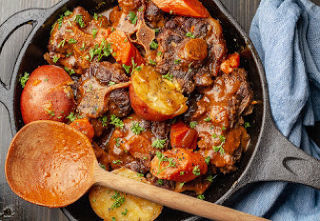 People don’t talk about oxtail stew these days, but it’s a true Primal-worthy classic. With an arguably richer taste than beef and more succulent feel when cooked for stew or soup, oxtail might just become a new favorite. But the real difference (and reason behind the appealing stewed texture) is the ample connective tissue—an incredible source of collagen for the benefit of skin, hair, joint health, performance and more. (Since we used bone broth here in lieu of water or regular stock, this recipe is one of the best you can make for collagen content.) You’ll enjoy warming up with this gelatinous, flavorful and hearty dish on a late winter night. And you might consider making an extra batch: it tastes even better the next day.
People don’t talk about oxtail stew these days, but it’s a true Primal-worthy classic. With an arguably richer taste than beef and more succulent feel when cooked for stew or soup, oxtail might just become a new favorite. But the real difference (and reason behind the appealing stewed texture) is the ample connective tissue—an incredible source of collagen for the benefit of skin, hair, joint health, performance and more. (Since we used bone broth here in lieu of water or regular stock, this recipe is one of the best you can make for collagen content.) You’ll enjoy warming up with this gelatinous, flavorful and hearty dish on a late winter night. And you might consider making an extra batch: it tastes even better the next day.
Time In the Kitchen: 25 minutes (plus cook time)
Servings: 4
Ingredients:
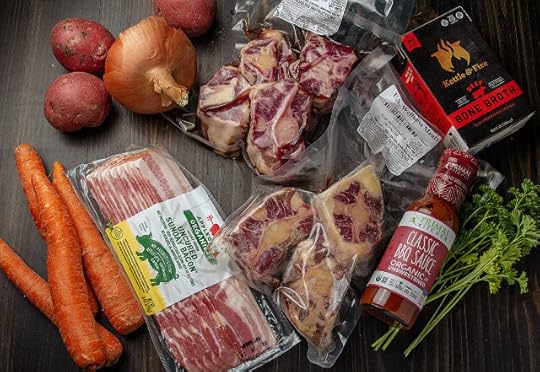
2 pounds grass-fed oxtail
1 1/4 cup beef bone broth
1/4 cup Primal Kitchen® Barbecue Sauce
1 lb. small red potatoes (about 6), cut into bite-size pieces
4 large carrots, cut into 1-inch-thick slices
1 large onion, cut into bite-size pieces
2 slices nitrate-free bacon, cut into 1-inch pieces
Salt and pepper to taste
Instructions:
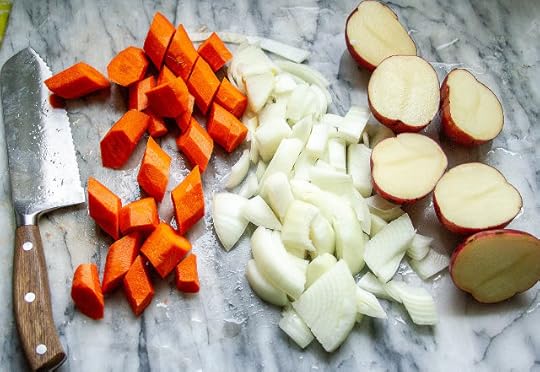
Heat Instant Pot on Saute and crisp chopped bacon. Remove and drain on paper towel.
Season oxtail and sear on all sides in bacon fat (3 min per side).
Add in other ingredients and cook 45 minutes on Manual High (Sealed). Let vent 15 minutes.
For slow cooker: cook bacon and sear oxtail in separate pan. Then cook all ingredients in slow cooker on low for 8 hours.

Nutritional Information (per serving):
Calories: 719
Net Carbs: 24.6 grams
Fat: 36 grams
Protein: 67 grams

The post Instant Pot Oxtail Stew appeared first on Mark's Daily Apple.



March 1, 2019
Weekly Link Love — Edition 18

Research of the Week
Poor quality relationships are harder on you than having too few.
Intelligence and rational thinking are not the same thing.
Move over, forest bathing. The hot new thing for Alzheimer’s is gene bathing for your brain.
Temporal comprehension of a story is better when you read a physical book versus using an e-reader.
Researchers discover evidence of an entirely new way of neural communication that can overcome complete gaps between severed brain tissues. They can’t explain it, but they know it’s there.
At least 116 individual genetic variants influence neuroticism.
Vitamin D influences brain scaffolding.
New Primal Blueprint Podcasts
Health Coach Radio is live! If you’re a health coach looking for tips, advice, and science-based insight on your profession—or are curious about joining the industry—you’ll love it. Episode 0 lays out what it’s all about, what you can expect from future episodes. I appear on Episode 1 to give my predictions about health coaching in the coming years and explore what it takes to start your own business. Check it out.

Episode 315: Dr. Anna Cabeca: Host Elle Russ chats with OBGYN Dr. Anna Cabeca about her new book, The Hormone Fix: Burn Fat Naturally, Boost Energy, Sleep Better, and Stop Hot Flashes, the Keto-Green Way.

Episode 316: Keto: Avoiding the Flight or Fight Response: Host Brad Kearns gives a sneak peek of the new keto book he and I are working on.

Each week, select Mark’s Daily Apple blog posts are prepared as Primal Blueprint Podcasts. Need to catch up on reading, but don’t have the time? Prefer to listen to articles while on the go? Check out the new blog post podcasts below, and subscribe to the Primal Blueprint Podcast here so you never miss an episode.
Media, Schmedia
Monty Don extols the virtues of gardening for mental health.
A popular vegan Youtuber has gone back to meat, raw eggs, and salmon for “health reasons.”
Ditching your phone to un-break your brain.
Interesting Blog Posts
A nice overview of the American health care crisis.
The importance of choline in pregnancy.
Social Notes
Here’s my best day.
Everything Else
How a small label change from the FDA may have kickstarted the opioid crisis.
IPA made with toasted marshmallows to evoke Saturday mornings spent watching cartoons over a big bowl of Lucky Charms.
Facial recognition for Chinese pigs.
I really want to go to this Viking restaurant.
Bronze Age Spaniards had pet foxes.
45,000 years ago in Sri Lankan jungles, humans were very good at catching monkeys and other small agile prey.
Things I’m Up to and Interested In
Unfortunate finding: 4-day and 5-day work weeks are not equally productive.
Concept I’m considering: Balancing long-term satisfaction with short-term happiness is the key to a good life in the age of the Internet.
Somehow I don’t think this will sway them: Lab-grown meat will probably be harder on the environmental than real meat.
The short answer is “no”: Are vegan diets safe for infants and small children?
This is powerful stuff: How indigenous people around the world give birth and care for babies.
Question I’m Asking
What makes a great day for you?
Recipe Corner
Buffalo chicken dip.
Basil coconut curry sounds really good right now.
Time Capsule
One year ago (Feb 24 –Mar 2)
Alternative Therapies for ADHD: Part 2 – What are some options?
How Bad Are Peanuts, Really?– Are these things off limits?
Comment of the Week
“So for this situation we should call it Kardio I suppose.”
– That’s pretty good, HealthyHombre.

The post Weekly Link Love — Edition 18 appeared first on Mark's Daily Apple.



February 28, 2019
Glute and Hamstring Workout
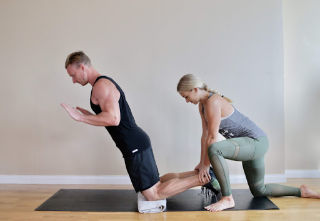 Jessica Gouthro from Paleohacks is joining us today to offer tips for strengthening glutes and hamstrings without traditional gym equipment. Enjoy, everyone.
Jessica Gouthro from Paleohacks is joining us today to offer tips for strengthening glutes and hamstrings without traditional gym equipment. Enjoy, everyone.
Strong glutes and hamstrings are more than just nice-looking legs and a booty.
The glutes and hamstrings are the strongest muscles in our skeletal muscular system. When we strengthen these muscles, we can prevent strain and injury while also enjoying a greater ability to squat deeper, lunge pain-free, push heavy objects, run faster and jump higher.
To best train those glutes and hamstrings, you’ll want to emphasize both leg curling (knee bending) and hip extension (or straightening) actions for balanced training. One of the best exercises that do this is the glute ham raise, or GHR.
Very few exercises can isolate the hamstrings and glutes without top-loading excess weight on the spine or testing your grip strength with a loaded barbell. Although you may think this exercise looks easy in comparison to a Barbell Romanian Deadlift or Hip Thrust, it is just as challenging (if not even more so) when performed correctly.
What Is a Glute Ham Raise?
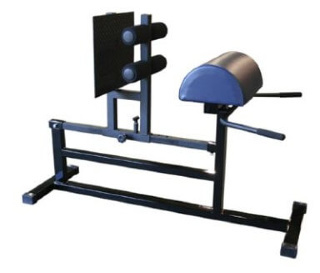 A glute ham raise is an eccentric, or muscle lengthening, exercise that involves a fixed location of the feet, ankles, and hips and a hinge only at the knee joint. By securing the foot position and starting with a bent knee, we enable the hamstring to lengthen eccentrically against gravity using only our own body weight.
A glute ham raise is an eccentric, or muscle lengthening, exercise that involves a fixed location of the feet, ankles, and hips and a hinge only at the knee joint. By securing the foot position and starting with a bent knee, we enable the hamstring to lengthen eccentrically against gravity using only our own body weight.
Rising back up to the starting position is done by a combination of hamstring contraction and assistance from the upper body pushing against the floor.
Typically, this exercise utilizes specialized equipment called a GHR machine (pictured) that can hold your feet and ankles in place and cushions your knees with a curved, shaped knee pad.
Since you may not have access to one of these in your home or gym, we have a great alternative you can do with a partner. All you need is a friend and a rolled-up towel to cushion your knees!
Partner Assisted Glute Ham Raise | 6 reps

Kneel down on a rolled-up towel. Tuck your toes under and straighten your hips. Lift your hands up in front of your shoulders and tighten your core.
Have your partner press down firmly on your ankles to secure your position. Keeping your hips and glutes tight, inhale as you slowly lean forward, hinging only at the knees.

Once you can no longer control the descent, use your hands to catch yourself and lower the rest of the way down. Push into the floor with your hands, and on an exhale, contract your glutes and hamstrings to rise back up to the starting position.

Complete six reps while your partner holds your ankles steady.
Note: This is an advanced exercise. If you find this exercise too challenging and cannot complete six good reps, you can try this next partner-assisted resistance band hamstring curl exercise as an alternative.
Partner-Assisted Kneeling Band Hamstring Curl | 8 reps per leg
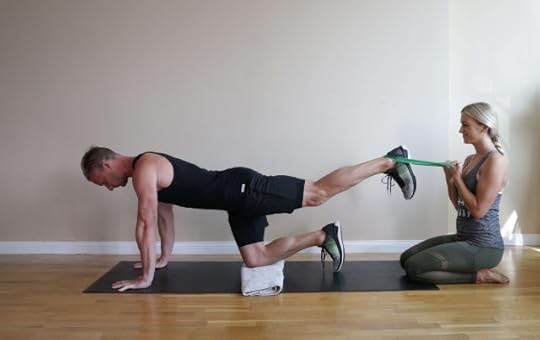
Kneel down on a rolled-up towel, tuck your toes under, and get into an all-fours position. Extend one leg straight out behind you.
Have your partner loop a resistance band around your heel, just above your shoe. As your partner holds her end of the resistance band tight, bend your knee to curl your heel towards your butt.

Exhale and hold momentarily at 90 degrees, then slowly straighten to return to the starting position. Continue to bend and straighten your knee while maintaining that lifted leg position. Complete eight reps, then switch sides.
Note: You will feel this in your glutes on both sides as well as in your hamstring.
In case you don’t have a partner available, here are the five best glute and hamstring exercises you can do anywhere, by yourself. You’ll need a yoga mat, a towel, and an exercise band.
To get the most out of your efforts, I recommend performing all of these exercises at least two to three times per week.
Fire Hydrant | 10 per side
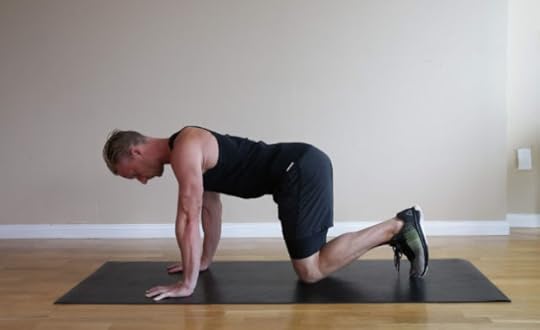
Kneel down in an all-fours position with your feet flexed (toes pointing to the floor). Lift one knee up and out to the side to hip height. Exhale at the top as you flex your glute muscles, then lower back down with control. Maintain a steady torso and upper body as you focus on contracting your glutes.
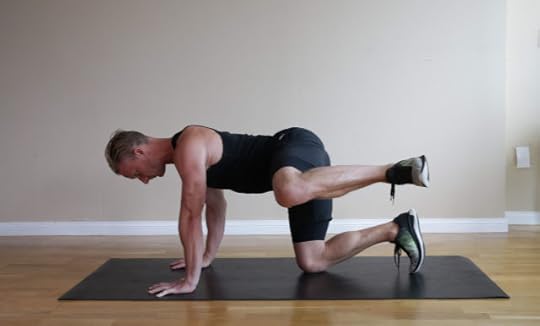
Complete 10 reps on one side, then switch to the other leg.
Note: Work slowly to ensure quality muscle contractions. Pause each time you hit the top and strongly contract your glutes. You’ll feel this on both sides, even though you’re working one side at a time.
Towel Slide Hamstring Curl | 8 reps

Sit at the bottom edge of your mat with the full length of your legs on a smooth surface floor, like hardwood or tile.
Lie down flat on your back and press your palms into the floor by your hips.
Place your heels on a towel and keep your feet flexed. (If you are working on carpet, use a piece of paper or two paper or plastic plates instead of a towel.)
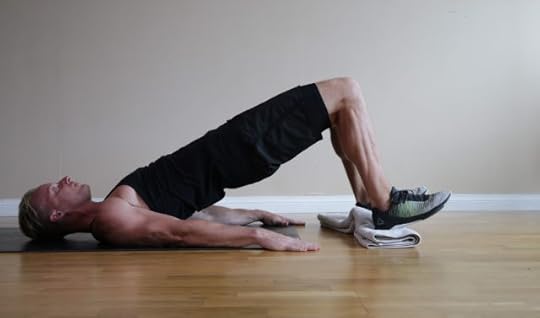
Engage your glutes and lift your hips off the ground. On an exhale, bend your knees to slide the towel towards your butt. Stop when your knees reach a 90-degree bend. Inhale, and reverse by sliding back out to a straight body.
Complete eight reps, keeping your hips elevated the entire time.
Single Leg Toe Touch | 6 reps per side
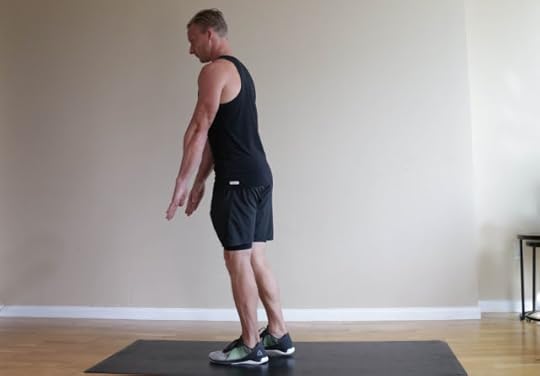
Stand tall with your core tight and shoulders rolled back and down. Balance on one foot as you float the other just off the ground.
Inhale to hinge at the hips to tilt forward until your torso and top leg are parallel to the ground. Keep a slight bend in your standing leg and reach your fingertips towards your toes. Exhale to lift back up to standing, contracting your muscles.
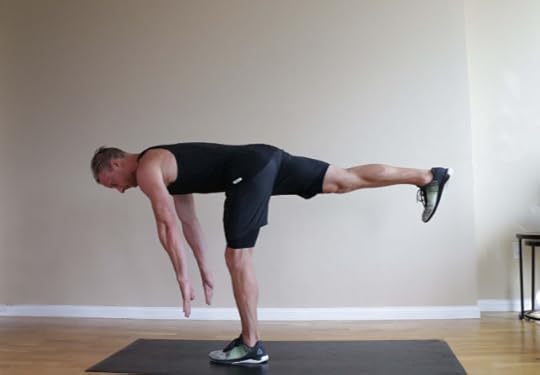
Complete six reps per side.
Note: Keep your gaze on the ground to help with balance. If balance is still a challenge, you may hold onto a wall or chair with one hand while you do these reps.
Single Leg Balance Hamstring Curl | 6 reps per side
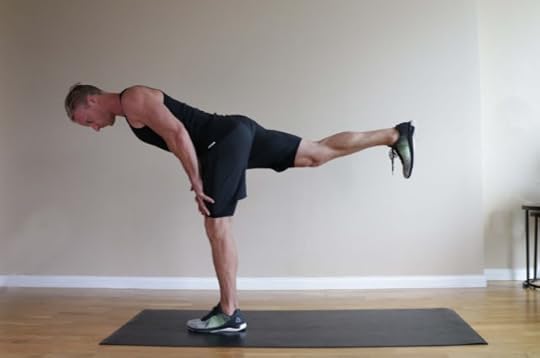
Balance on one leg with your torso and lifted leg parallel to the ground. Keep a small bend in your standing leg, and grab onto your quad for stability. On an exhale, curl your top leg towards your butt, while maintaining your hip and torso position.

Inhale to straighten your leg, reaching it out long behind you.
Continue six reps on one side, then complete six reps on the other side.
Single Leg Resistance Band Ham Curl | 6 reps per side
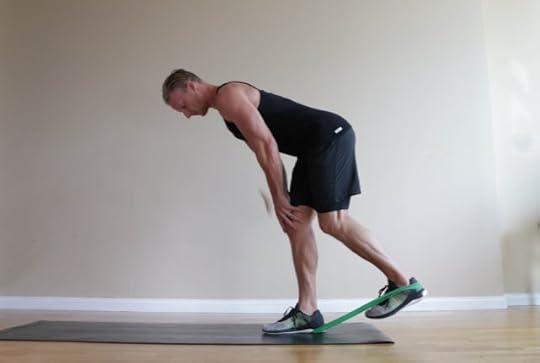
Slide one end of your loop resistance band underneath your left heel, pressing down with your heel to secure its position.
Lift your right leg. Loop your right heel through the other end of the band, positioning it on the back of your shoe. Place both hands on your left knee and hinge at your hips with your spine straight.
Exhale to bend your right knee to 90 degrees, then inhale as you lower back down with control, maintaining a small amount of tension on the band so it does not come loose. Your range of motion should be about eight to 10 inches.
Complete six reps, then switch sides.
Note: Hold onto a wall or a chair for balance if you need to.
How To Incorporate This Weekly Workout
Here’s a sample workout you can incorporate into your weekly routine.
Warm up with three minutes of light walking or jogging. Follow with three rounds of the circuit of seven exercises, resting for 10-30 seconds between exercises depending on your fitness level.
Note: Beginners can do just one round and work up to three rounds after a few weeks.
Partner-Assisted Glute Ham Raise [OR] Partner Assisted Kneeling Band | 6 reps
Hamstring Curl | 8 reps per leg
Fire Hydrant | 10 per side
Towel Slide Hamstring Curl | 8 reps
Single Leg Toe Touch | 6 reps per side
Single Leg Balance Hamstring Curl | 6 reps per side
Single Leg Resistance Band Ham Curl | 6 reps per side
Thanks again to Jessica Gouthro for these tips and to Brad Gouthro for demonstrating them. Be sure to check out Jessica’s other workout lineups on MDA:“Arm Workout Without Weights,” “13 Ways To Move More At Work” and “10 Moves To Help Ease Joint Pain.”
Questions or comments about exercises or glute and hamstring strength? Share them below, and thanks for stopping by.

The post Glute and Hamstring Workout appeared first on Mark's Daily Apple.



Mark Sisson's Blog
- Mark Sisson's profile
- 199 followers



